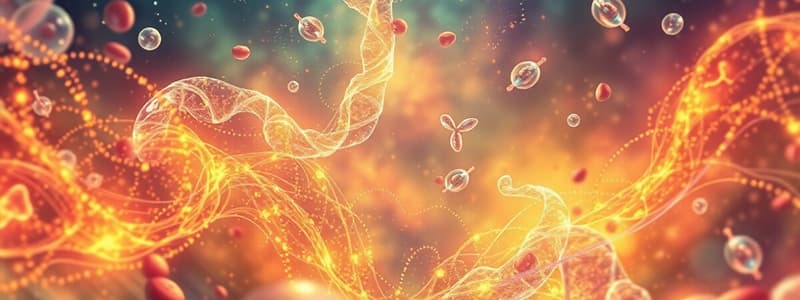Podcast
Questions and Answers
What is the primary biological function of carbohydrates?
What is the primary biological function of carbohydrates?
- Source of metabolic energy (correct)
- Storage of genetic information
- Formation of muscle tissue
- Transport of oxygen in blood
Which type of carbohydrate is defined as containing more than 10 sugar units?
Which type of carbohydrate is defined as containing more than 10 sugar units?
- Disaccharides
- Oligosaccharides
- Monosaccharides
- Polysaccharides (correct)
Which of the following foods is not a source of carbohydrates?
Which of the following foods is not a source of carbohydrates?
- Milk
- Potatoes
- Bread
- Beef (correct)
How are monosaccharides classified based on the functional group present?
How are monosaccharides classified based on the functional group present?
What term describes carbohydrates that serve as building blocks for other molecules?
What term describes carbohydrates that serve as building blocks for other molecules?
Which carbohydrate serves as the primary energy storage molecule in animals?
Which carbohydrate serves as the primary energy storage molecule in animals?
Which of the following is NOT a classification based on the number of sugar units in carbohydrates?
Which of the following is NOT a classification based on the number of sugar units in carbohydrates?
What is the role of carbohydrates in cell membranes?
What is the role of carbohydrates in cell membranes?
Which statement accurately describes the function of ribose in biological systems?
Which statement accurately describes the function of ribose in biological systems?
Which monosaccharide is specifically synthesized in the mammary gland?
Which monosaccharide is specifically synthesized in the mammary gland?
What characteristic must a carbon atom have to be considered asymmetric?
What characteristic must a carbon atom have to be considered asymmetric?
What determines whether a sugar is classified as a D-sugar or L-sugar?
What determines whether a sugar is classified as a D-sugar or L-sugar?
Which of the following is the sugar commonly found in blood?
Which of the following is the sugar commonly found in blood?
Which monosaccharide is a constituent of many glycoproteins?
Which monosaccharide is a constituent of many glycoproteins?
Which of the following is true about stereoisomers?
Which of the following is true about stereoisomers?
Which monosaccharide falls under the category of ketoses?
Which monosaccharide falls under the category of ketoses?
Flashcards are hidden until you start studying
Study Notes
Carbohydrates: An Introduction
- Most abundant form of organic matter on Earth
- Consist of carbon, hydrogen, and oxygen
- Produced via photosynthesis, combining carbon dioxide and water
- Essential for all living organisms
Biological Importance of Carbohydrates
- Primary source of metabolic energy for plants and animals
- Building blocks for other essential molecules (fats, amino acids, nucleic acids)
- Found in cell surface receptors, cell membranes, DNA, RNA, and vitamins B2 and C
- Dietary fibers can help lower blood glucose and cholesterol levels, and prevent constipation
Classification of Carbohydrates
- Categorized based on the number of sugar units in the chain
- Monosaccharides: Single sugar unit (simple sugars)
- Disaccharides: Two sugar units
- Oligosaccharides: 3 to 10 sugar units
- Polysaccharides: More than 10 sugar units
Monosaccharides
- Building blocks of carbohydrates
- Classified based on the presence of an aldehyde or ketone group and number of carbon atoms
- Aldoses: Contain an aldehyde group
- Ketoses: Contain a ketone group
- Trioses: 3 carbon atoms
- Tetroses: 4 carbon atoms
- Pentoses: 5 carbon atoms
- Hexoses: 6 carbon atoms
- Heptoses: 7 carbon atoms
Examples of Monosaccharides
- Ribose: Component of ribonucleic acid (RNA)
- Deoxyribose: Component of deoxyribonucleic acid (DNA)
- Glucose: Blood sugar
- Fructose: Sugar found in semen
- Galactose: Synthesized in mammary glands to form lactose (milk sugar)
- Mannose: Component of many glycoproteins
Physical Properties & Configuration of Monosaccharides
- Asymmetric Carbon: A carbon atom attached to four different chemical groups
- All monosaccharides (except dihydroxyacetone) contain asymmetric carbon atoms
- This leads to the formation of stereoisomers, compounds with identical chemical groups but different spatial arrangements
- D and L forms:
- Determined by the orientation of the hydroxyl (OH) group on the carbon atom adjacent to the last carbon in the molecule
- D-sugars: OH group on the right side
- L-sugars: OH group on the left side
- Almost all naturally occurring carbs are in the D-configuration
Sugars and Oral Health
- Sugars and fermentable carbohydrates provide substrate for oral bacteria
- Bacteria produce acid, lowering salivary pH, initiating tooth demineralization.
Studying That Suits You
Use AI to generate personalized quizzes and flashcards to suit your learning preferences.




